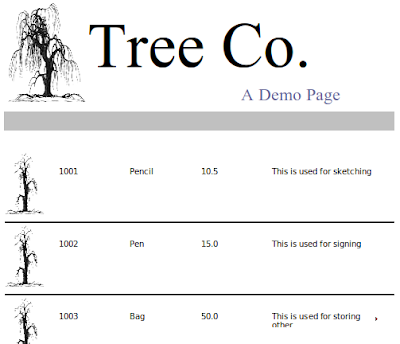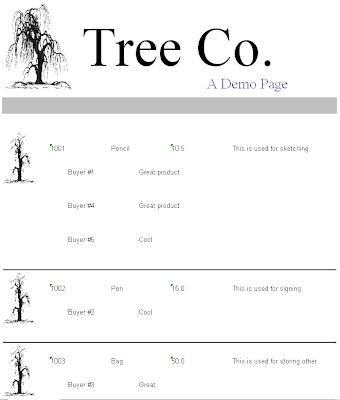What is Jasper Reports?
JasperReports is the world's most popular open source reporting engine. It is entirely written in Java and it is able to use data coming from any kind of data source and produce pixel-perfect documents that can be viewed, printed or exported in a variety of document formats including HTML, PDF, Excel, OpenOffice and Word.
Source: http://jasperforge.org/projects/jasperreports
What are Sub-reports?
Sub-reports are normal Jasper reports. They're called sub-reports because they are embedded within a report. The structure and data access is essentially the same.
Similar with our previous tutorial. We will setup our Spring 3 MVC application first. If you need a review with Spring MVC, I suggest you read the other tutorials I've posted. Or you can also Google for related tutorials.
The image below is an actual screenshot of our report without the sub-report:

With sub-report added, here's the new image:

We added two extra fields: buyer and remarks field. These two fields are located in the sub-report. These fields are placed in the Detail section of the report layout. The data will be repeated as many times as the number of rows in your datasource. You can place conditions inside your sub-report to restrict the data that gets repeated.
Using iReport we can generate both report layouts. On the final document, the master and sub-report are merged as if there's only a single document.
Here's the master report:

The highlighted gray rectangle indicates an embedded sub-report. The format is exactly the same as we had in our previous Jasper tutorial. If you need to a refresher, feel free to read that tutorial first.
Here's the sub-report:

Notice we have two Parameters here. Both have the same identifier $P{PARENT_ID}. Actually, the fields are too short to show the whole Parameter names. If we examine the JRXML file, here's what we will see:
The two fields are actually condition statements:
($P{PARENT_ID}).equals($F{id})?$F{buyer}:""
($P{PARENT_ID}).equals($F{id})?$F{remarks}:""Each condition means if the parameter PARENT_ID is equal to the field id then display the buyer field. If they're not equal, display an empty string. So basically on the sub-report we show an empty string if the id doesn't match.
There's a problem with that. Yes, it's going to print empty strings but these empty strings will still occupy space in the report. The yellow boxes show these empty spaces.

To fix this behavior, we add the following element just right after the band element:
This means "Show me this section if the PARENT_ID matches the field id" This means we can re-write our field expression from:
($P{PARENT_ID}).equals($F{id})?$F{buyer}:""
($P{PARENT_ID}).equals($F{id})?$F{remarks}:""to this
$F{buyer}
$F{remarks}
Here's our updated sub-report JRXML file:
For the purpose of this tutorial I will keep the old way:
($P{PARENT_ID}).equals($F{id})?$F{buyer}:""
($P{PARENT_ID}).equals($F{id})?$F{remarks}:""Let's keep in mind that such expression exists. Eventually we might find some use for such expressions.
Let's view the final structure of our project.

Besides the Spring XML files, these are all the files we need for this project.
We can now begin our project.
Our first task is to setup the main controller that will handle the download request.
This controller declares three mappings:
/download - for showing the download page /download/xls - for retrieving the actual Excel report /download/pdf - for retrieving the actual PDF report
If you notice in each request handlers, we return an instance of ModelAndView. The view names are declared on a separate XML file under /WEB-INF/jasper-views.xml
jasper-views.xml
We have declared four beans in this XML file. Each bean uses a Spring built-in view for Jasper that corresponds to a specific format. Take note of these special properties for each view:
id url reportDateKey subReportUrls subReportDataKeys
Also take note of the following sub-report variables:
JasperCustomSubReportLocation JasperCustomSubReportDatasource
We declared these two variables in the master JRXML report file named tree-template.jrxml.
First, in the headers:
Second, in the subreport element:
If you want to see the whole JRXML file, you can find it in the downloadable project at the end of this tutorial. If you look carefully at the following line:
We have basically wrapped our sub-report datasource JasperCustomSubReportDatasource with a JRBeanCollectionDataSource. This is important if you want to see your data repeated over multiple rows. Otherwise, all your data will be consumed by the first record. See this post at SpringSource forums for more info.
Let's examine further the contents of the subreport element:
Here we're referencing a single sub-report parameter: PARENT_ID. This parameter is declared inside the sub-report JRXML file itself. We've declared how to populate this parameter. We instructed Jasper "Hey, Jasper this is what you need to do when you encounter this parameter". For example, in the PARENT_ID parameter, we wrote:
[CDATA[$F{id}]]This means take and assign the value of the Field id.
In this tutorial the PARENT_ID and id point to the same value so that the parent table has a relation with its child table. For example, an address to a person, there must be an identifier that links between the two. Maybe, we can use the person's id. This means the person's id must be present in the Person's table and in the Address table.
Let's return to the master report.
If you examine the header of the master report file, you'll see the following field declarations:
If you look back at the MainController, the master report and the sub-report have their own distinct data sources.
SalesDAO
Our datasources are simple array lists populated with simple POJO instances.
Sales
Remarks
Our application is almost finished. We just need to setup some required Spring configuration files.
To enable Spring MVC we need to add it in the web.xml
web.xml
Take note of the URL pattern. When accessing any pages in our MVC application, the host name must be appended with
/krams
In the web.xml we declared a servlet-name spring. By convention, we must declare a spring-servlet.xml as well.
spring-servlet.xml
By convention, we must declare an applicationContext.xml as well.
applicationContext.xml
Our application is now finished. We've managed to setup a simple Spring 3 MVC application with reporting capabilities using Jasper. We've managed to add a master report and sub-report using two distinct data sources. We've also leveraged Spring's MVC programming model via annotation.
To access the download page, enter the following URL:
http://localhost:8080/spring-jasper-subreport-dual/krams/main/download
If you want to download the report directly, enter the following URL for XLS format:
http://localhost:8080/spring-jasper-subreport-dual/krams/main/download/xls
For PDF format, enter the following URL:
http://localhost:8080/spring-jasper-subreport-dual/krams/main/download/pdf
For HTML and CSV, I left this exercise for my readers.
The best way to learn further is to try the actual application.
Download the project
You can access the project site at Google's Project Hosting at http://code.google.com/p/spring-mvc-jasper-integration-tutorial/
You can download the project as a Maven build. Look for the spring-jasper-subreport-dual.zip in the Download sections.
You can run the project directly using an embedded server via Maven.
For Tomcat: mvn tomcat:run
For Jetty: mvn jetty:run
If you want to learn more about Spring MVC and Jasper, feel free to read my other tutorials in the Tutorials section.
For more info about Sub-reports, check the following:
Spring Framework Reference: Chapter 17.7 JasperReports
JasperForge: Subreports! by Giulio Toffoli
|
Share the joy:
|
I have got a problem in generating sub Report
ReplyDeletecan you help me with it
I have read your blog its very attractive and impressive. I like it your blog.
ReplyDeleteSpring online training Spring online training Spring Hibernate online training Spring Hibernate online training Java online training
spring training in chennai spring hibernate training in chennai
Hello sir , please send this whole project to me
ReplyDeleteIt was excellent and really informative.I also like composing something if my downtime. So I could find out something from your write-up. Thanks.
ReplyDeleteBest BCA Colleges in Noida
Good Post! Thank you so much for sharing this pretty post, it was so good to read and useful to improve my knowledge as updated one, keep blogging.
ReplyDeletecore java training in Electronic City
Hibernate Training in electronic city
spring training in electronic city
java j2ee training in electronic city